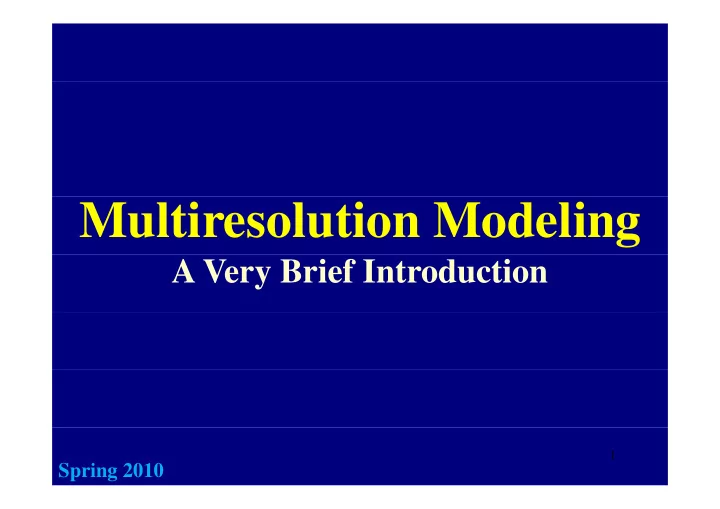

Multiresolution Modeling A Very Brief Introduction 1 Spring 2010
Multiresolution Multiresolution Models: Multiresolution Multiresolution Models: Models: Definition odels: Definition Definition Definition � A multiresolution model consists of a collection of � Mesh fragments, usually describing small g y g portions of an object with different LOD ( i.e ., level of details) � Suitable relations that allow selecting a subset of fragments (according to user-defined quality of fragments (according to user defined quality criteria) and combining them into a mesh that represents the object. represents the object. 2
Multiresolution Multiresolution Models: Multiresolution Multiresolution Models: Models: LOD odels: LOD LOD LOD � There is no universally accepted definition for � Th i i ll d d fi i i f LOD, level of details. In general, more faces means more details and perhaps higher accuracy means more details and perhaps higher accuracy. � Thus, to accurately represent a curvilinear objects a large number of small faces may be objects, a large number of small faces may be needed ( i.e ., higher LOD or resolution). � Not all meshes in a scene require very high � Not all meshes in a scene require very high resolution. For example, back faces of an object or objects very far away from the camera do not or objects very far away from the camera do not need much details. 3
Multiresolution Models: Multiresolution Models: Approaches 1/2 Approaches 1/2 � There are in general two different approaches: � On-the-Fly ( i.e ., real time): A new mesh with y ( ) the desired resolution is constructed from scratch whenever it is needed. � Off-Line: Design a data structure to collect the mesh fragments and relations in a the mesh fragments and relations in a preprocessing step, and generate the new mesh with a given resolution on-line. mesh with a given resolution on line. 4
Multiresolution Models: Multiresolution Models: Approaches 2/2 Approaches 2/2 resolution input model requirements q multi-resolution query construction model model processing processing desired mesh off line on line off-line on-line 5
Modifications: Modifications: 1/3 Modifications: 1/3 Modifications: 1/3 1/3 � A � A modification (of a mesh) M is the basic operation h) M i th b difi ti ( f i ti of changing a mesh X 1 1 locally to mesh X 2 written as M : X 1 ⇒ X 2 , or M =( X 1 , X 2 ). M X X M ( X X ) � A modification is a refinement ( resp ., coarsening ) if X 2 has more ( resp ., less) faces than X 1 has. the yellow region of X the yellow region of X 1 is is M M re-tessellated to yield X 2 ⇒ 6 X 1 X 2
Modifications: Modifications: 2/3 Modifications: Modifications: 2/3 2/3 2/3 � Not all modifications are independent of each other. M j M i X 3 X 1 M j removes some faces inserted by M i 7 X 2 X 4
Modifications: Modifications: Modifications: 3/3 Modifications: 3/3 3/3 3/3 � Gi � Given two modifications M i =( X p , X q ) and M ( X X ) difi i d M j =( X s , X t ), if modification M j removes some faces inserted by M i , we say M j directly depends faces inserted by M we say M directly depends on M i , written as M i < M j . � Given two modifications they are either � Given two modifications, they are either independent of each other, M i < M j or M j < M i . � We may apply all possible modifications to a � We may apply all possible modifications to a mesh or to its intermediate results until the simplest mesh is obtained. simplest mesh is obtained. � The modifications may be the Euler operators used in mesh simplifications. used in mesh simplifications. 8
Multiresolution Multiresolution Multiresolution DAG: Multiresolution DAG: DAG: 1/3 DAG: 1/3 1/3 1/3 � The base mesh X 0 , all modifications M 1 , M 2 , …, M k , and the dependency relation < together form a multiresolution model M =[ X 0 ,{ M 1 , M X { M f i i M 2 , …, M k }, < ] � Why do we keep track modifications rather than the intermediate results? This is because we can regenerate them from X 0 and the necessary modifications. Storing intermediate results may require very high space consumption. 9
Multiresolution Multiresolution DAG: Multiresolution Multiresolution DAG: DAG: 2/3 DAG: 2/3 2/3 2/3 � A directed graph can be constructed as follows: � The root is X 0 , the base mesh 0 � The directed arcs from X 0 are all modifications applied to X 0 modifications applied to X 0 � If there is a modification M i < M j , draw a directed arc from M to M directed arc from M i to M j . � In this way, we have a directed acyclic graph, DAG So those M ’s are nodes of this DAG! DAG. So, those M i ’s are nodes of this DAG! � Why is it a DAG? 10
Multiresolution Multiresolution DAG: Multiresolution Multiresolution DAG: DAG: 3/3 DAG: 3/3 3/3 3/3 � With a multiresolution model, we can do the following: 1. Given a “resolution/LOD” requirement, we may perform a depth-first search (DFS) or y p p any search from the root until an intermediate result which satisfies the desired resolution. 2. Selected refinement is also possible. Given a region of a mesh and a “resolution/LOD” region of a mesh and a resolution/LOD requirement, we may perform a search and only “refine” the mesh in the indicated region. o y e e t e es t e d cated eg o . 11
The End The End 12
Recommend
More recommend